ACC 3015: Financial Performance Analysis of UK Food Companies Report
VerifiedAdded on 2023/01/03
|17
|3438
|74
Report
AI Summary
This report provides a comprehensive financial analysis of three companies listed on the London Stock Exchange: Greencore Group Plc, Hilton Food Group Plc, and Premier Foods Plc. It begins by examining the strategic plans of each company, considering their goals, strategies, and responses to market challenges like the COVID-19 pandemic and Brexit. The report then conducts a detailed evaluation of their financial performance using ratio analysis, comparing metrics like current ratio, debt-to-assets ratio, return on capital employed, and profit margins to develop a performance ranking. Based on this ranking, an investment opportunity case is presented. The second section explores the sources of internal and external long-term financing available to large companies, including retained earnings and loans from financial institutions, and includes a stakeholder analysis. The report concludes with a summary of the key findings and recommendations.
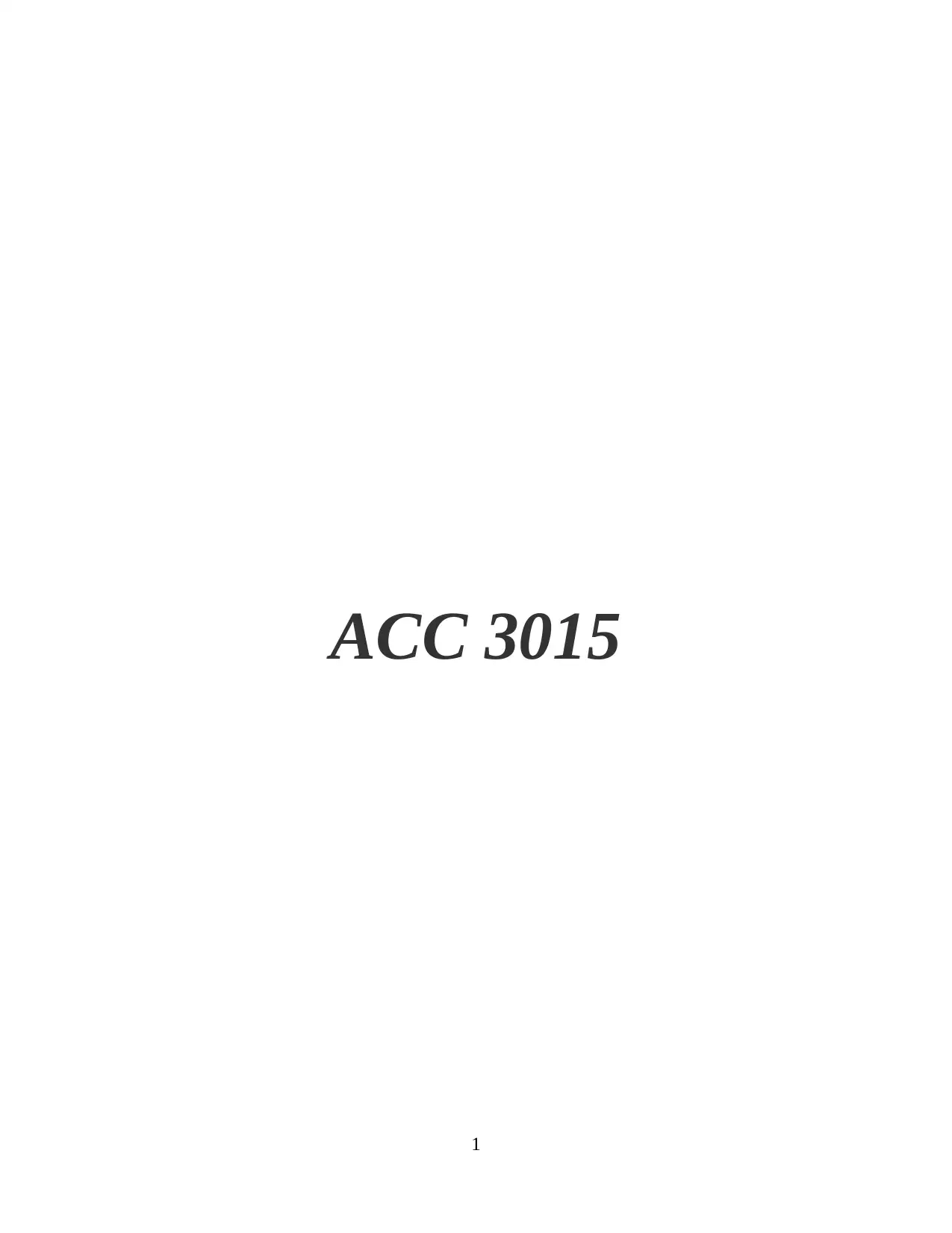
ACC 3015
1
1
Paraphrase This Document
Need a fresh take? Get an instant paraphrase of this document with our AI Paraphraser
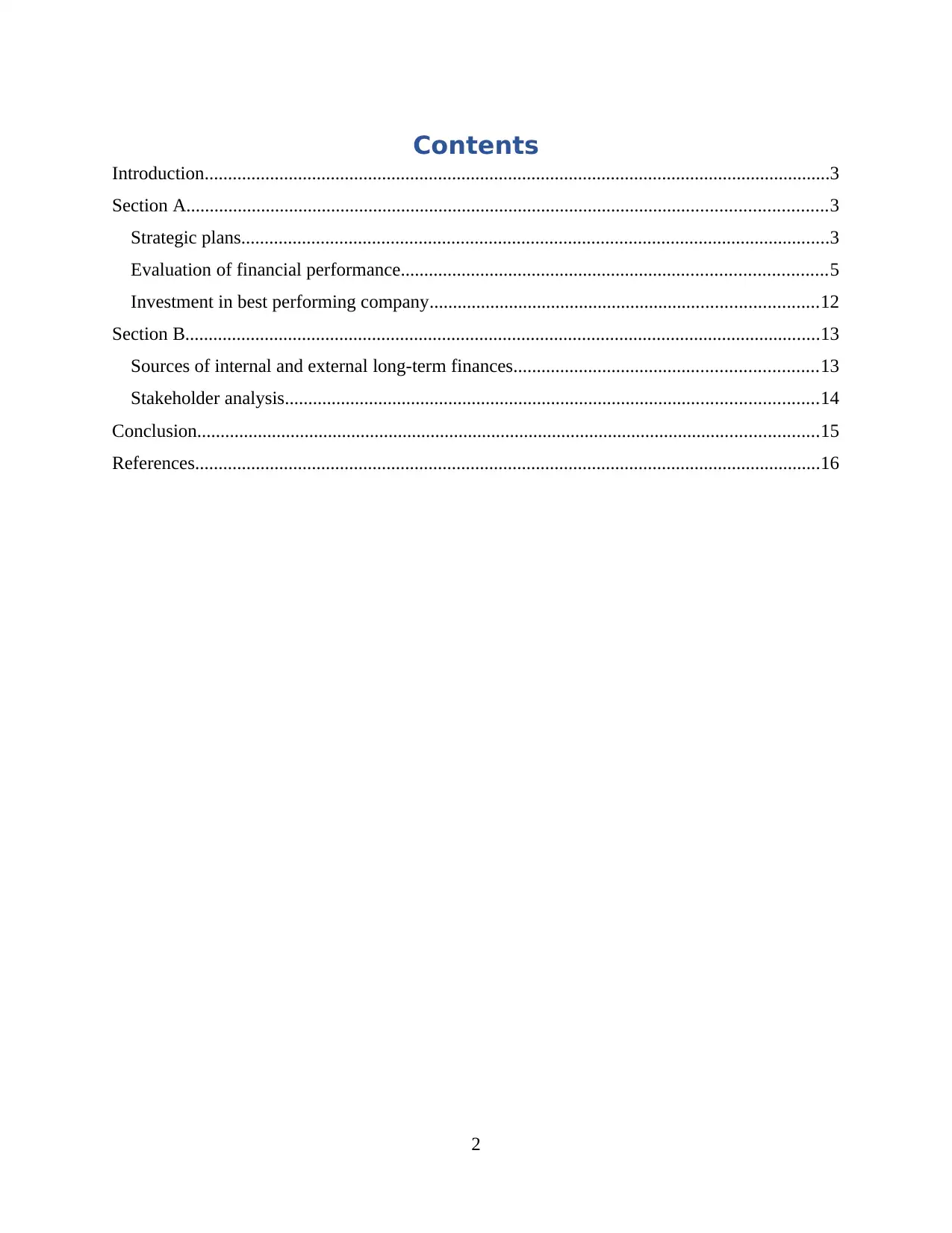
Contents
Introduction......................................................................................................................................3
Section A.........................................................................................................................................3
Strategic plans..............................................................................................................................3
Evaluation of financial performance...........................................................................................5
Investment in best performing company...................................................................................12
Section B........................................................................................................................................13
Sources of internal and external long-term finances.................................................................13
Stakeholder analysis..................................................................................................................14
Conclusion.....................................................................................................................................15
References......................................................................................................................................16
2
Introduction......................................................................................................................................3
Section A.........................................................................................................................................3
Strategic plans..............................................................................................................................3
Evaluation of financial performance...........................................................................................5
Investment in best performing company...................................................................................12
Section B........................................................................................................................................13
Sources of internal and external long-term finances.................................................................13
Stakeholder analysis..................................................................................................................14
Conclusion.....................................................................................................................................15
References......................................................................................................................................16
2
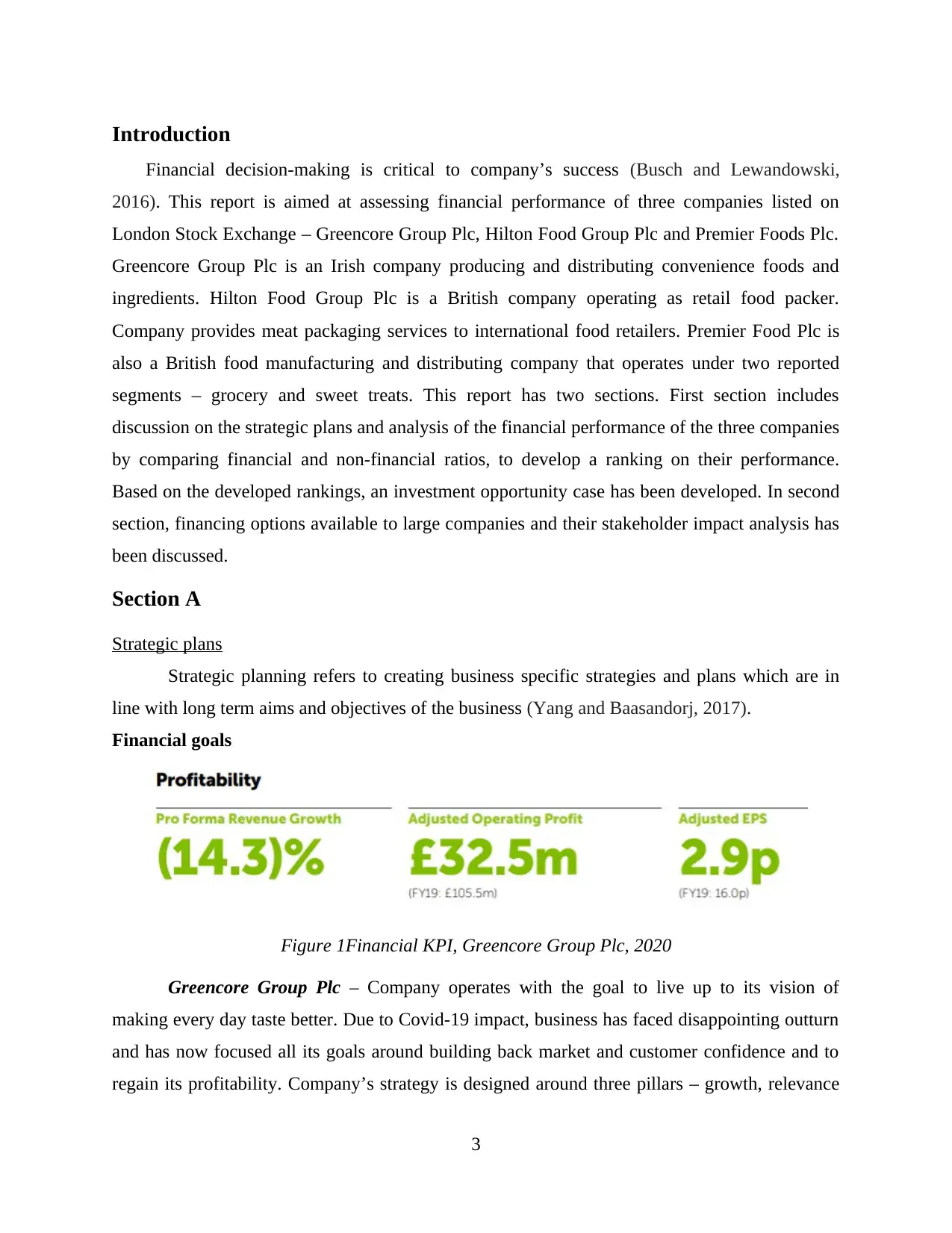
Introduction
Financial decision-making is critical to company’s success (Busch and Lewandowski,
2016). This report is aimed at assessing financial performance of three companies listed on
London Stock Exchange – Greencore Group Plc, Hilton Food Group Plc and Premier Foods Plc.
Greencore Group Plc is an Irish company producing and distributing convenience foods and
ingredients. Hilton Food Group Plc is a British company operating as retail food packer.
Company provides meat packaging services to international food retailers. Premier Food Plc is
also a British food manufacturing and distributing company that operates under two reported
segments – grocery and sweet treats. This report has two sections. First section includes
discussion on the strategic plans and analysis of the financial performance of the three companies
by comparing financial and non-financial ratios, to develop a ranking on their performance.
Based on the developed rankings, an investment opportunity case has been developed. In second
section, financing options available to large companies and their stakeholder impact analysis has
been discussed.
Section A
Strategic plans
Strategic planning refers to creating business specific strategies and plans which are in
line with long term aims and objectives of the business (Yang and Baasandorj, 2017).
Financial goals
Figure 1Financial KPI, Greencore Group Plc, 2020
Greencore Group Plc – Company operates with the goal to live up to its vision of
making every day taste better. Due to Covid-19 impact, business has faced disappointing outturn
and has now focused all its goals around building back market and customer confidence and to
regain its profitability. Company’s strategy is designed around three pillars – growth, relevance
3
Financial decision-making is critical to company’s success (Busch and Lewandowski,
2016). This report is aimed at assessing financial performance of three companies listed on
London Stock Exchange – Greencore Group Plc, Hilton Food Group Plc and Premier Foods Plc.
Greencore Group Plc is an Irish company producing and distributing convenience foods and
ingredients. Hilton Food Group Plc is a British company operating as retail food packer.
Company provides meat packaging services to international food retailers. Premier Food Plc is
also a British food manufacturing and distributing company that operates under two reported
segments – grocery and sweet treats. This report has two sections. First section includes
discussion on the strategic plans and analysis of the financial performance of the three companies
by comparing financial and non-financial ratios, to develop a ranking on their performance.
Based on the developed rankings, an investment opportunity case has been developed. In second
section, financing options available to large companies and their stakeholder impact analysis has
been discussed.
Section A
Strategic plans
Strategic planning refers to creating business specific strategies and plans which are in
line with long term aims and objectives of the business (Yang and Baasandorj, 2017).
Financial goals
Figure 1Financial KPI, Greencore Group Plc, 2020
Greencore Group Plc – Company operates with the goal to live up to its vision of
making every day taste better. Due to Covid-19 impact, business has faced disappointing outturn
and has now focused all its goals around building back market and customer confidence and to
regain its profitability. Company’s strategy is designed around three pillars – growth, relevance
3
⊘ This is a preview!⊘
Do you want full access?
Subscribe today to unlock all pages.

Trusted by 1+ million students worldwide
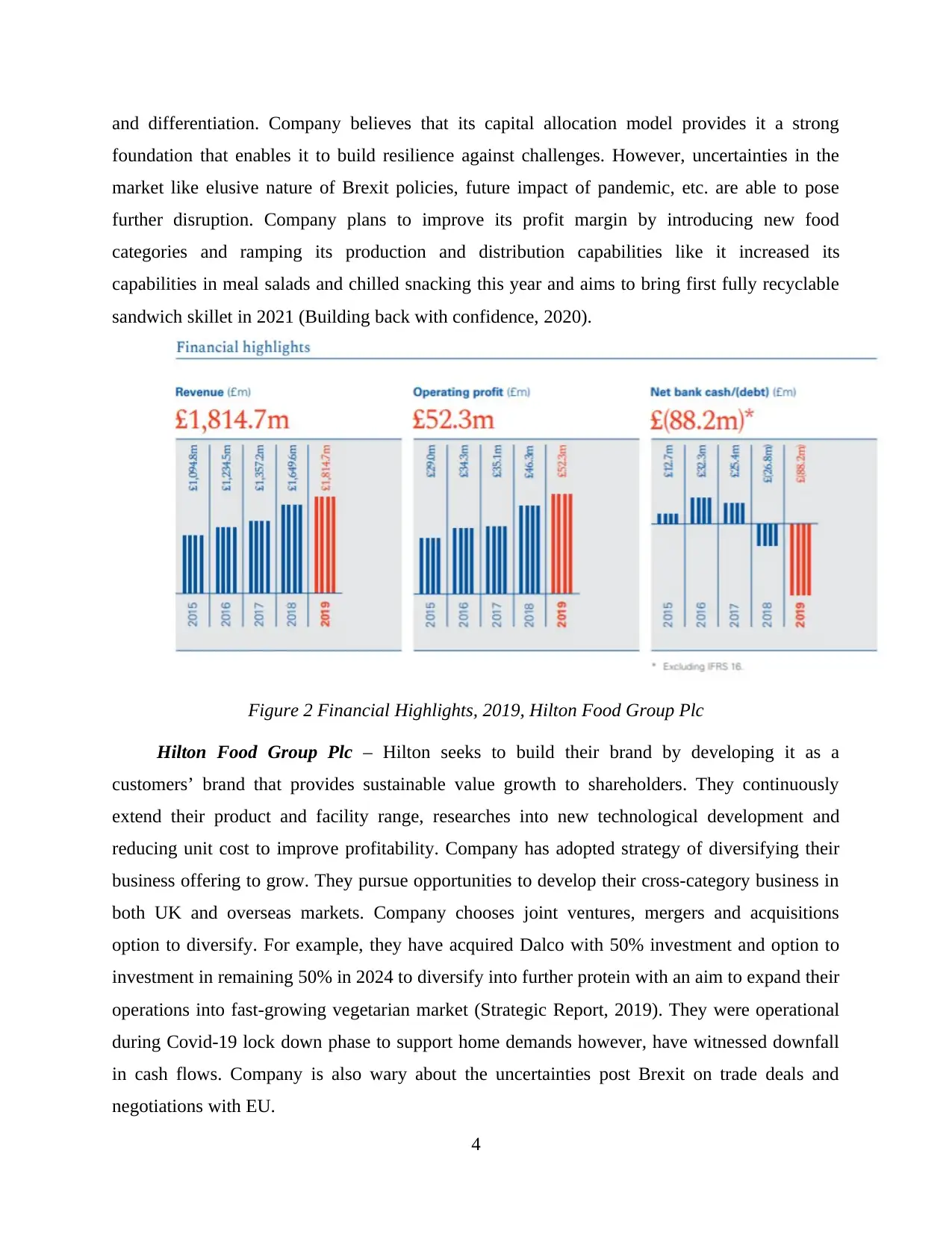
and differentiation. Company believes that its capital allocation model provides it a strong
foundation that enables it to build resilience against challenges. However, uncertainties in the
market like elusive nature of Brexit policies, future impact of pandemic, etc. are able to pose
further disruption. Company plans to improve its profit margin by introducing new food
categories and ramping its production and distribution capabilities like it increased its
capabilities in meal salads and chilled snacking this year and aims to bring first fully recyclable
sandwich skillet in 2021 (Building back with confidence, 2020).
Figure 2 Financial Highlights, 2019, Hilton Food Group Plc
Hilton Food Group Plc – Hilton seeks to build their brand by developing it as a
customers’ brand that provides sustainable value growth to shareholders. They continuously
extend their product and facility range, researches into new technological development and
reducing unit cost to improve profitability. Company has adopted strategy of diversifying their
business offering to grow. They pursue opportunities to develop their cross-category business in
both UK and overseas markets. Company chooses joint ventures, mergers and acquisitions
option to diversify. For example, they have acquired Dalco with 50% investment and option to
investment in remaining 50% in 2024 to diversify into further protein with an aim to expand their
operations into fast-growing vegetarian market (Strategic Report, 2019). They were operational
during Covid-19 lock down phase to support home demands however, have witnessed downfall
in cash flows. Company is also wary about the uncertainties post Brexit on trade deals and
negotiations with EU.
4
foundation that enables it to build resilience against challenges. However, uncertainties in the
market like elusive nature of Brexit policies, future impact of pandemic, etc. are able to pose
further disruption. Company plans to improve its profit margin by introducing new food
categories and ramping its production and distribution capabilities like it increased its
capabilities in meal salads and chilled snacking this year and aims to bring first fully recyclable
sandwich skillet in 2021 (Building back with confidence, 2020).
Figure 2 Financial Highlights, 2019, Hilton Food Group Plc
Hilton Food Group Plc – Hilton seeks to build their brand by developing it as a
customers’ brand that provides sustainable value growth to shareholders. They continuously
extend their product and facility range, researches into new technological development and
reducing unit cost to improve profitability. Company has adopted strategy of diversifying their
business offering to grow. They pursue opportunities to develop their cross-category business in
both UK and overseas markets. Company chooses joint ventures, mergers and acquisitions
option to diversify. For example, they have acquired Dalco with 50% investment and option to
investment in remaining 50% in 2024 to diversify into further protein with an aim to expand their
operations into fast-growing vegetarian market (Strategic Report, 2019). They were operational
during Covid-19 lock down phase to support home demands however, have witnessed downfall
in cash flows. Company is also wary about the uncertainties post Brexit on trade deals and
negotiations with EU.
4
Paraphrase This Document
Need a fresh take? Get an instant paraphrase of this document with our AI Paraphraser
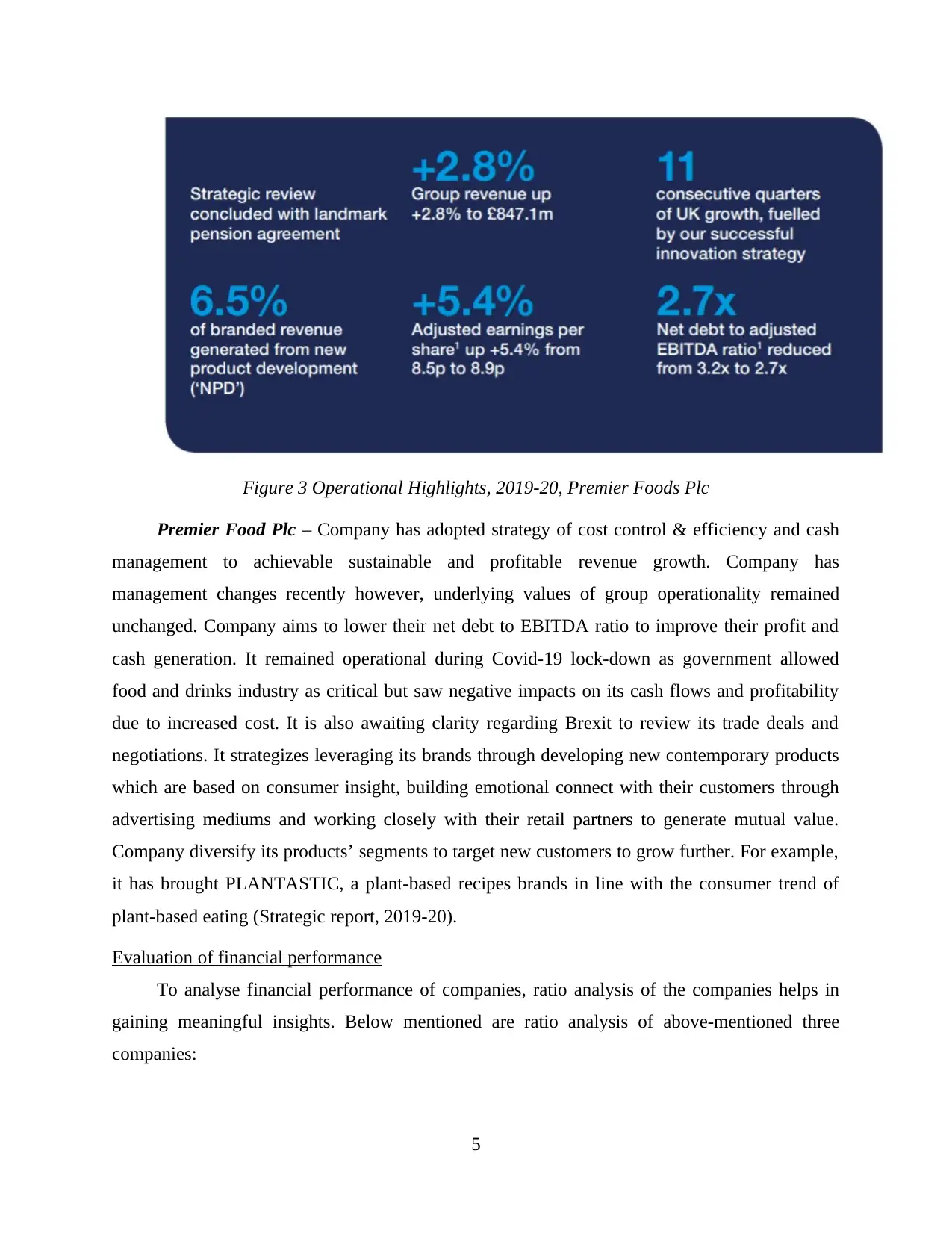
Figure 3 Operational Highlights, 2019-20, Premier Foods Plc
Premier Food Plc – Company has adopted strategy of cost control & efficiency and cash
management to achievable sustainable and profitable revenue growth. Company has
management changes recently however, underlying values of group operationality remained
unchanged. Company aims to lower their net debt to EBITDA ratio to improve their profit and
cash generation. It remained operational during Covid-19 lock-down as government allowed
food and drinks industry as critical but saw negative impacts on its cash flows and profitability
due to increased cost. It is also awaiting clarity regarding Brexit to review its trade deals and
negotiations. It strategizes leveraging its brands through developing new contemporary products
which are based on consumer insight, building emotional connect with their customers through
advertising mediums and working closely with their retail partners to generate mutual value.
Company diversify its products’ segments to target new customers to grow further. For example,
it has brought PLANTASTIC, a plant-based recipes brands in line with the consumer trend of
plant-based eating (Strategic report, 2019-20).
Evaluation of financial performance
To analyse financial performance of companies, ratio analysis of the companies helps in
gaining meaningful insights. Below mentioned are ratio analysis of above-mentioned three
companies:
5
Premier Food Plc – Company has adopted strategy of cost control & efficiency and cash
management to achievable sustainable and profitable revenue growth. Company has
management changes recently however, underlying values of group operationality remained
unchanged. Company aims to lower their net debt to EBITDA ratio to improve their profit and
cash generation. It remained operational during Covid-19 lock-down as government allowed
food and drinks industry as critical but saw negative impacts on its cash flows and profitability
due to increased cost. It is also awaiting clarity regarding Brexit to review its trade deals and
negotiations. It strategizes leveraging its brands through developing new contemporary products
which are based on consumer insight, building emotional connect with their customers through
advertising mediums and working closely with their retail partners to generate mutual value.
Company diversify its products’ segments to target new customers to grow further. For example,
it has brought PLANTASTIC, a plant-based recipes brands in line with the consumer trend of
plant-based eating (Strategic report, 2019-20).
Evaluation of financial performance
To analyse financial performance of companies, ratio analysis of the companies helps in
gaining meaningful insights. Below mentioned are ratio analysis of above-mentioned three
companies:
5
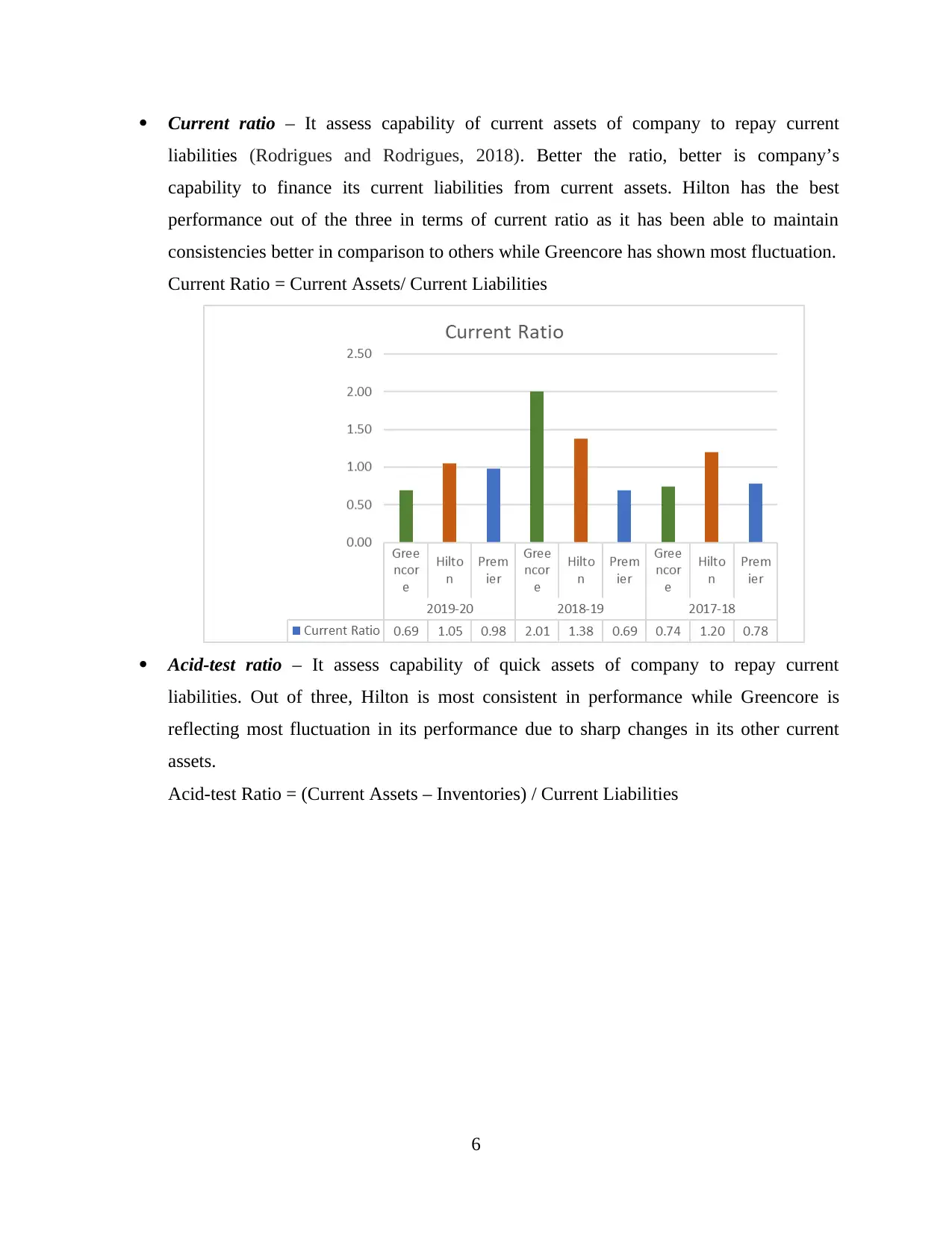
Current ratio – It assess capability of current assets of company to repay current
liabilities (Rodrigues and Rodrigues, 2018). Better the ratio, better is company’s
capability to finance its current liabilities from current assets. Hilton has the best
performance out of the three in terms of current ratio as it has been able to maintain
consistencies better in comparison to others while Greencore has shown most fluctuation.
Current Ratio = Current Assets/ Current Liabilities
Acid-test ratio – It assess capability of quick assets of company to repay current
liabilities. Out of three, Hilton is most consistent in performance while Greencore is
reflecting most fluctuation in its performance due to sharp changes in its other current
assets.
Acid-test Ratio = (Current Assets – Inventories) / Current Liabilities
6
liabilities (Rodrigues and Rodrigues, 2018). Better the ratio, better is company’s
capability to finance its current liabilities from current assets. Hilton has the best
performance out of the three in terms of current ratio as it has been able to maintain
consistencies better in comparison to others while Greencore has shown most fluctuation.
Current Ratio = Current Assets/ Current Liabilities
Acid-test ratio – It assess capability of quick assets of company to repay current
liabilities. Out of three, Hilton is most consistent in performance while Greencore is
reflecting most fluctuation in its performance due to sharp changes in its other current
assets.
Acid-test Ratio = (Current Assets – Inventories) / Current Liabilities
6
⊘ This is a preview!⊘
Do you want full access?
Subscribe today to unlock all pages.

Trusted by 1+ million students worldwide
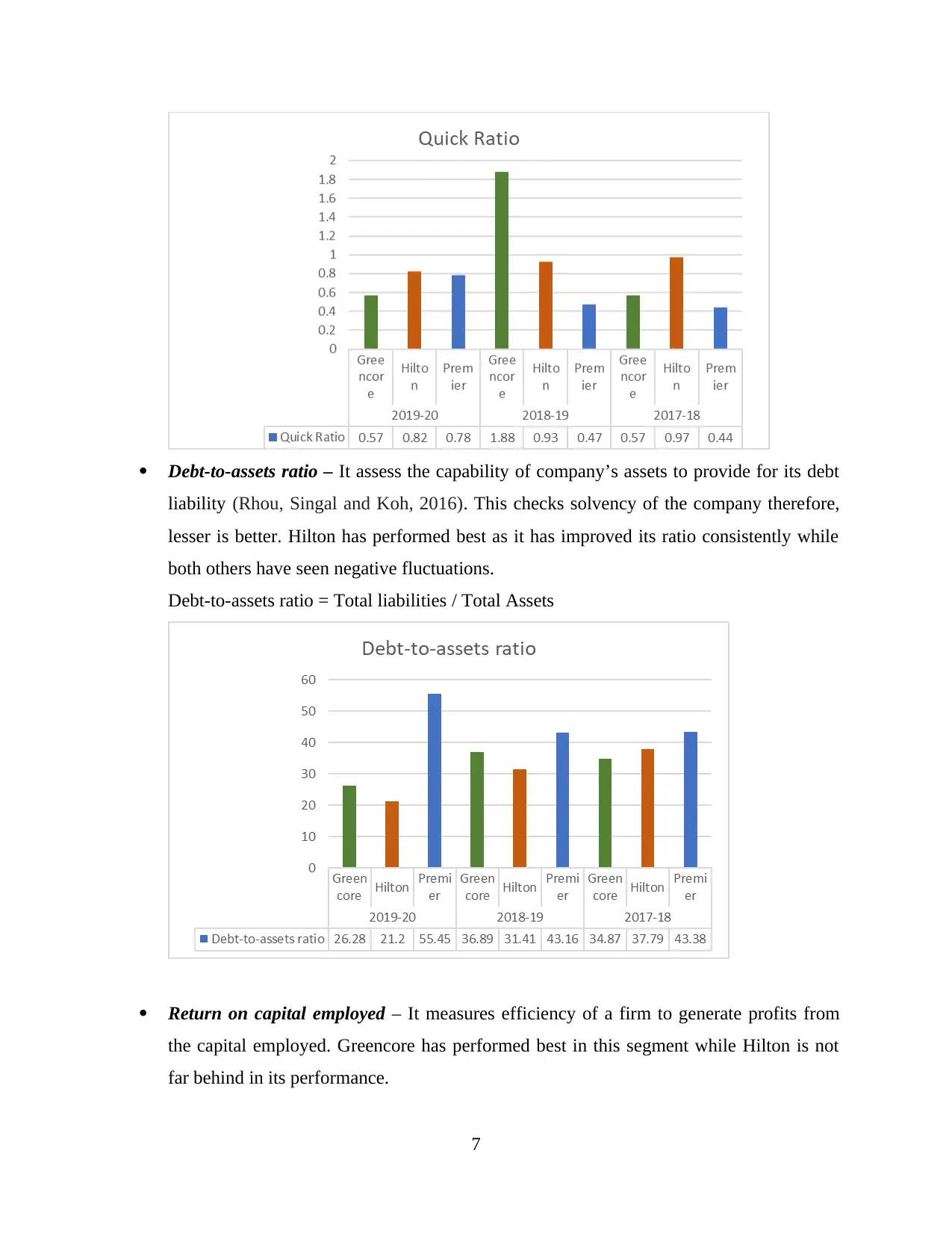
Debt-to-assets ratio – It assess the capability of company’s assets to provide for its debt
liability (Rhou, Singal and Koh, 2016). This checks solvency of the company therefore,
lesser is better. Hilton has performed best as it has improved its ratio consistently while
both others have seen negative fluctuations.
Debt-to-assets ratio = Total liabilities / Total Assets
Return on capital employed – It measures efficiency of a firm to generate profits from
the capital employed. Greencore has performed best in this segment while Hilton is not
far behind in its performance.
7
liability (Rhou, Singal and Koh, 2016). This checks solvency of the company therefore,
lesser is better. Hilton has performed best as it has improved its ratio consistently while
both others have seen negative fluctuations.
Debt-to-assets ratio = Total liabilities / Total Assets
Return on capital employed – It measures efficiency of a firm to generate profits from
the capital employed. Greencore has performed best in this segment while Hilton is not
far behind in its performance.
7
Paraphrase This Document
Need a fresh take? Get an instant paraphrase of this document with our AI Paraphraser
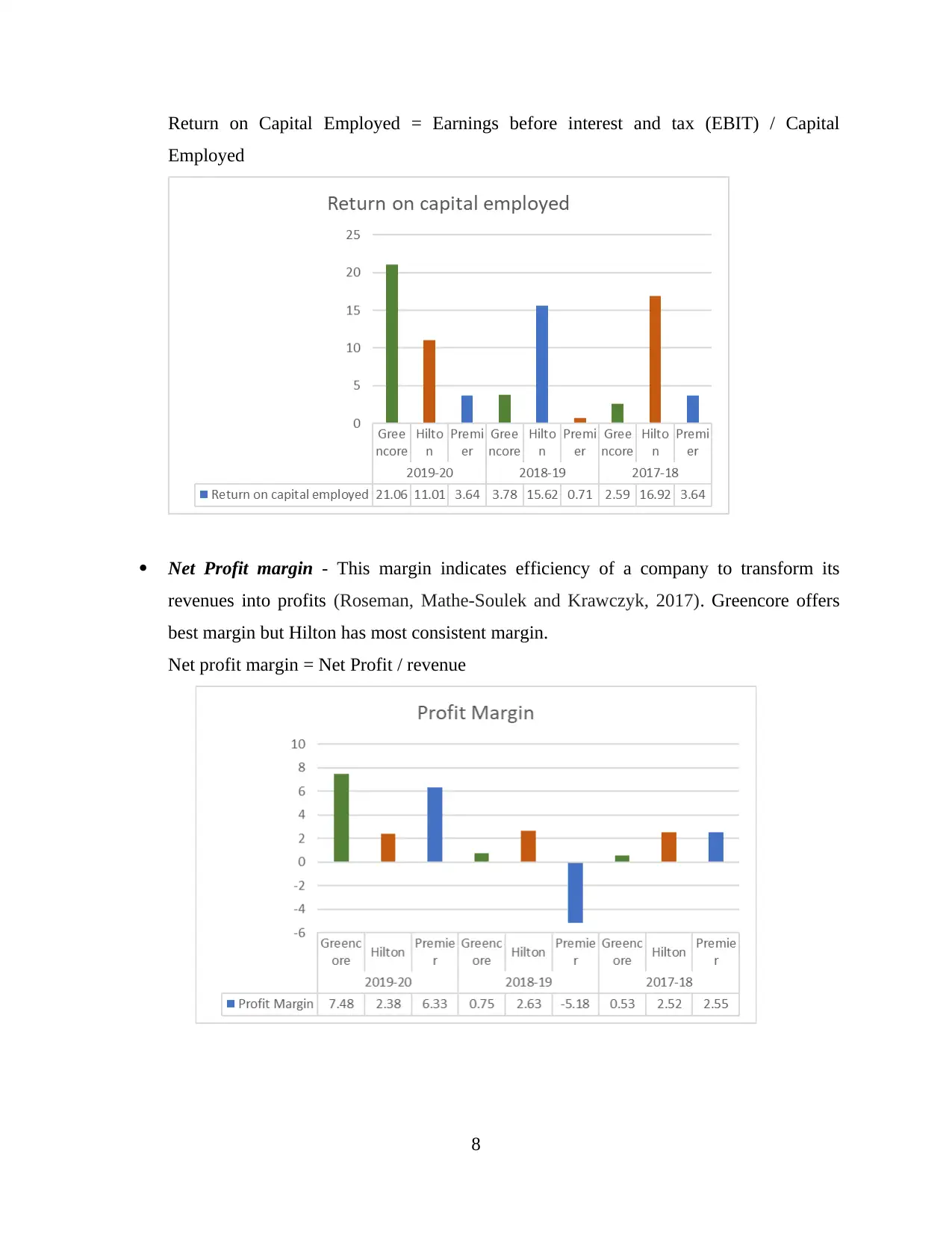
Return on Capital Employed = Earnings before interest and tax (EBIT) / Capital
Employed
Net Profit margin - This margin indicates efficiency of a company to transform its
revenues into profits (Roseman, Mathe-Soulek and Krawczyk, 2017). Greencore offers
best margin but Hilton has most consistent margin.
Net profit margin = Net Profit / revenue
8
Employed
Net Profit margin - This margin indicates efficiency of a company to transform its
revenues into profits (Roseman, Mathe-Soulek and Krawczyk, 2017). Greencore offers
best margin but Hilton has most consistent margin.
Net profit margin = Net Profit / revenue
8
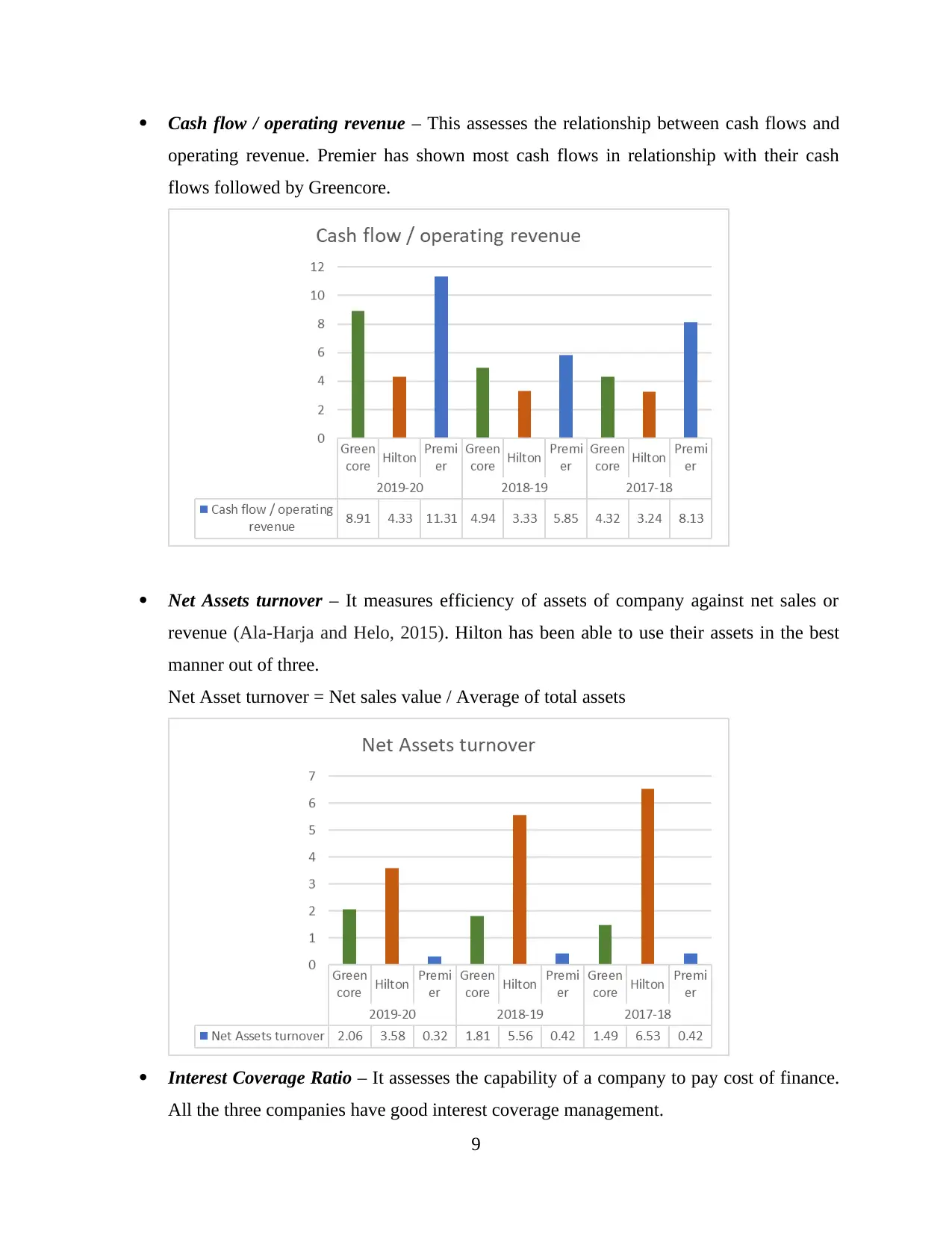
Cash flow / operating revenue – This assesses the relationship between cash flows and
operating revenue. Premier has shown most cash flows in relationship with their cash
flows followed by Greencore.
Net Assets turnover – It measures efficiency of assets of company against net sales or
revenue (Ala-Harja and Helo, 2015). Hilton has been able to use their assets in the best
manner out of three.
Net Asset turnover = Net sales value / Average of total assets
Interest Coverage Ratio – It assesses the capability of a company to pay cost of finance.
All the three companies have good interest coverage management.
9
operating revenue. Premier has shown most cash flows in relationship with their cash
flows followed by Greencore.
Net Assets turnover – It measures efficiency of assets of company against net sales or
revenue (Ala-Harja and Helo, 2015). Hilton has been able to use their assets in the best
manner out of three.
Net Asset turnover = Net sales value / Average of total assets
Interest Coverage Ratio – It assesses the capability of a company to pay cost of finance.
All the three companies have good interest coverage management.
9
⊘ This is a preview!⊘
Do you want full access?
Subscribe today to unlock all pages.

Trusted by 1+ million students worldwide
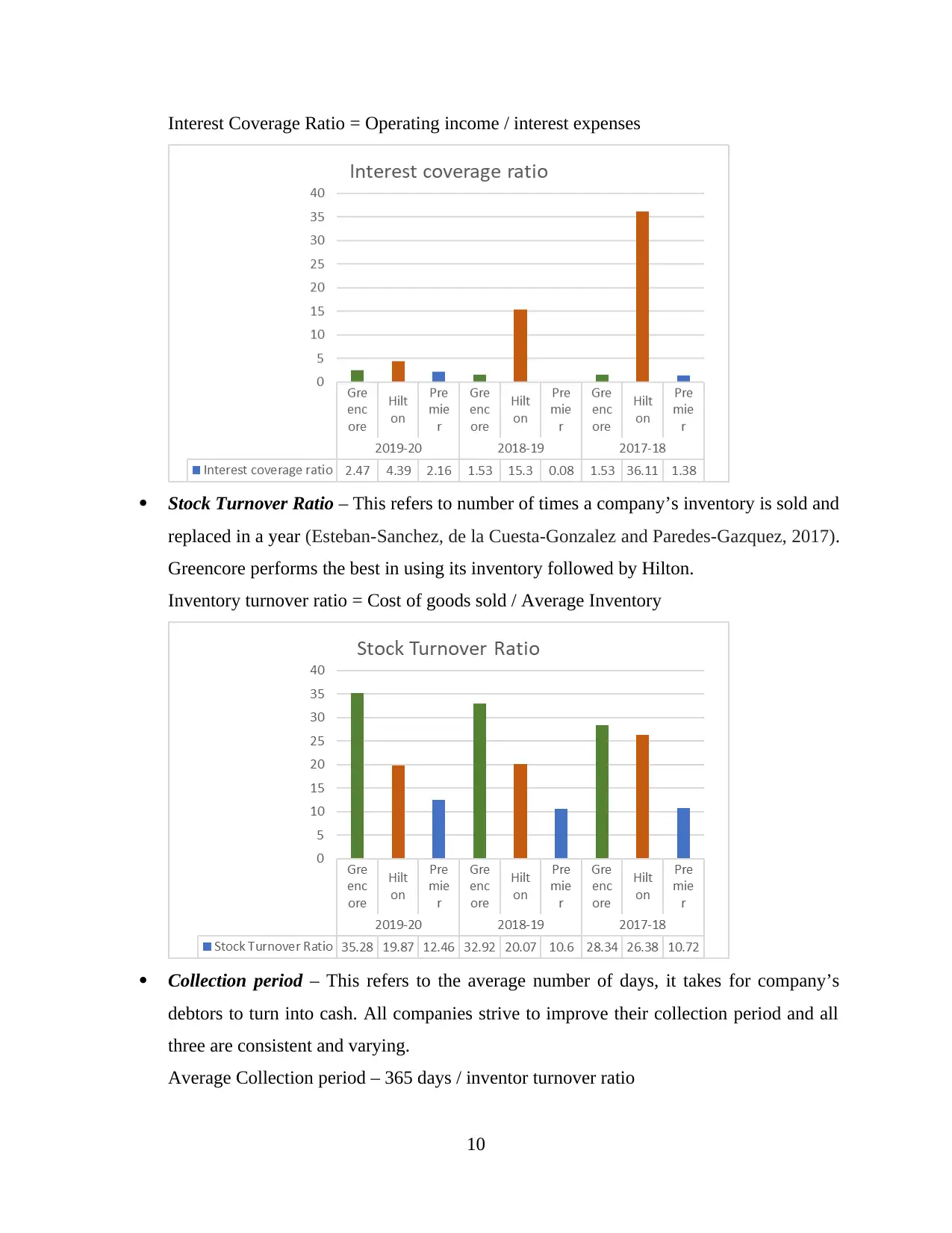
Interest Coverage Ratio = Operating income / interest expenses
Stock Turnover Ratio – This refers to number of times a company’s inventory is sold and
replaced in a year (Esteban-Sanchez, de la Cuesta-Gonzalez and Paredes-Gazquez, 2017).
Greencore performs the best in using its inventory followed by Hilton.
Inventory turnover ratio = Cost of goods sold / Average Inventory
Collection period – This refers to the average number of days, it takes for company’s
debtors to turn into cash. All companies strive to improve their collection period and all
three are consistent and varying.
Average Collection period – 365 days / inventor turnover ratio
10
Stock Turnover Ratio – This refers to number of times a company’s inventory is sold and
replaced in a year (Esteban-Sanchez, de la Cuesta-Gonzalez and Paredes-Gazquez, 2017).
Greencore performs the best in using its inventory followed by Hilton.
Inventory turnover ratio = Cost of goods sold / Average Inventory
Collection period – This refers to the average number of days, it takes for company’s
debtors to turn into cash. All companies strive to improve their collection period and all
three are consistent and varying.
Average Collection period – 365 days / inventor turnover ratio
10
Paraphrase This Document
Need a fresh take? Get an instant paraphrase of this document with our AI Paraphraser
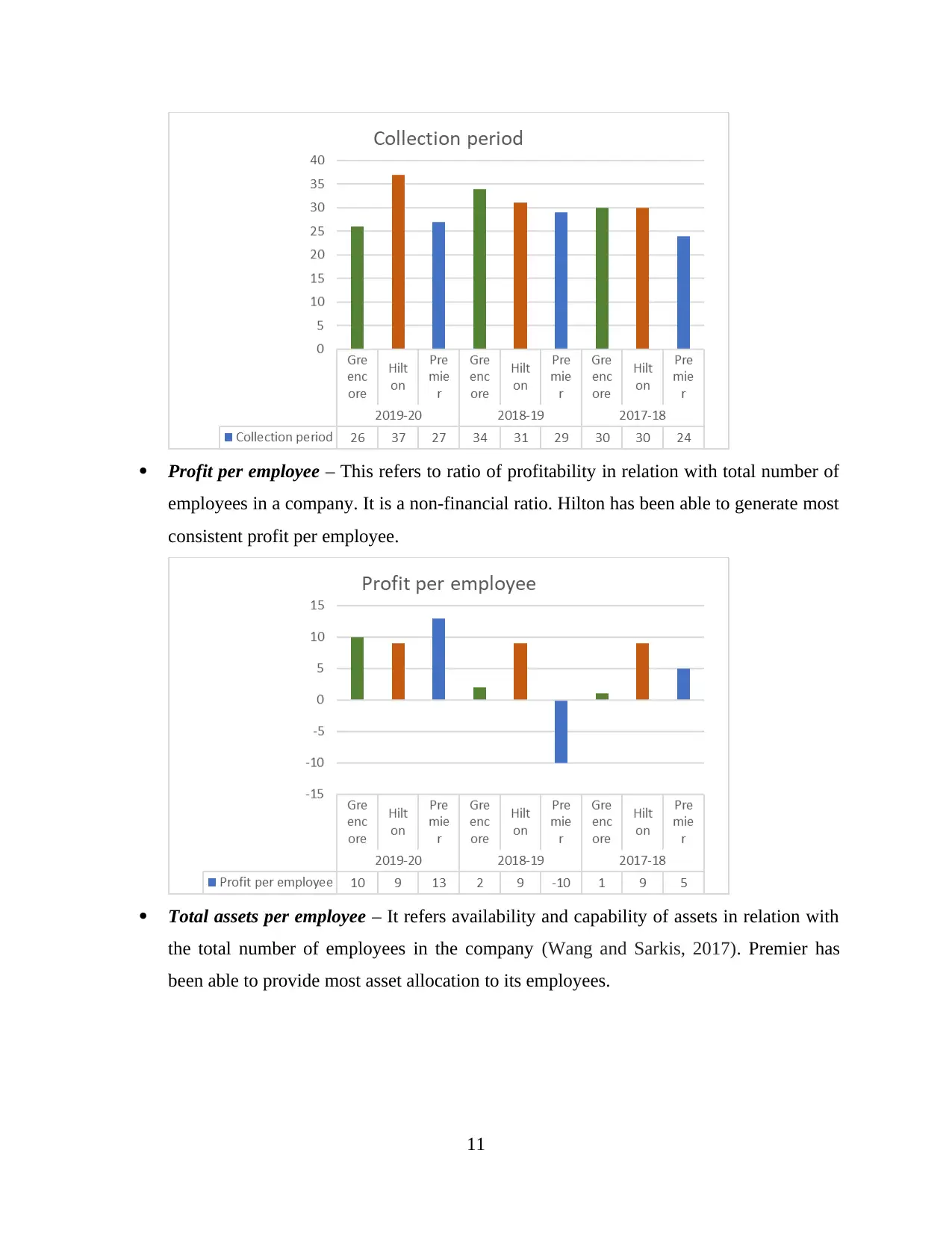
Profit per employee – This refers to ratio of profitability in relation with total number of
employees in a company. It is a non-financial ratio. Hilton has been able to generate most
consistent profit per employee.
Total assets per employee – It refers availability and capability of assets in relation with
the total number of employees in the company (Wang and Sarkis, 2017). Premier has
been able to provide most asset allocation to its employees.
11
employees in a company. It is a non-financial ratio. Hilton has been able to generate most
consistent profit per employee.
Total assets per employee – It refers availability and capability of assets in relation with
the total number of employees in the company (Wang and Sarkis, 2017). Premier has
been able to provide most asset allocation to its employees.
11
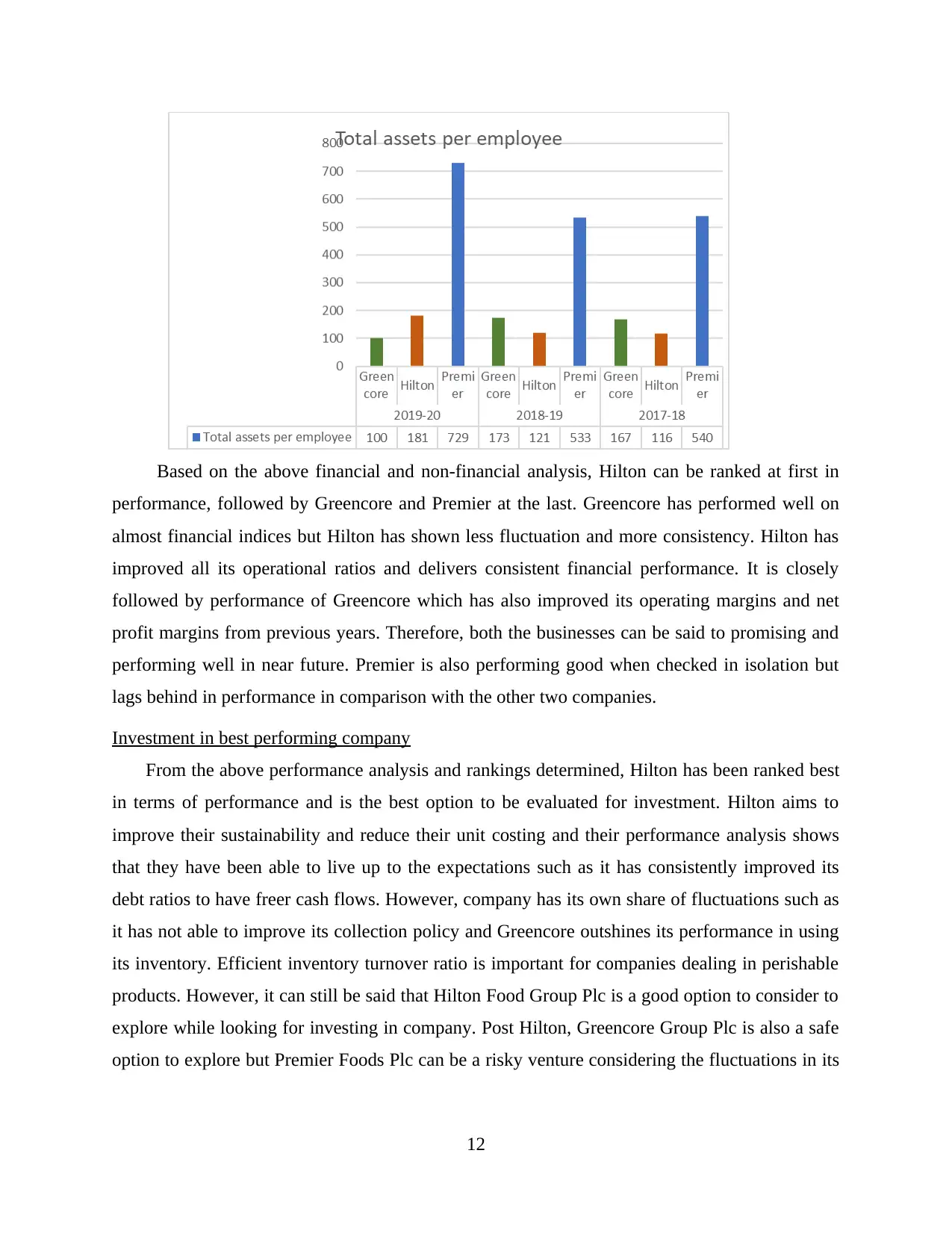
Based on the above financial and non-financial analysis, Hilton can be ranked at first in
performance, followed by Greencore and Premier at the last. Greencore has performed well on
almost financial indices but Hilton has shown less fluctuation and more consistency. Hilton has
improved all its operational ratios and delivers consistent financial performance. It is closely
followed by performance of Greencore which has also improved its operating margins and net
profit margins from previous years. Therefore, both the businesses can be said to promising and
performing well in near future. Premier is also performing good when checked in isolation but
lags behind in performance in comparison with the other two companies.
Investment in best performing company
From the above performance analysis and rankings determined, Hilton has been ranked best
in terms of performance and is the best option to be evaluated for investment. Hilton aims to
improve their sustainability and reduce their unit costing and their performance analysis shows
that they have been able to live up to the expectations such as it has consistently improved its
debt ratios to have freer cash flows. However, company has its own share of fluctuations such as
it has not able to improve its collection policy and Greencore outshines its performance in using
its inventory. Efficient inventory turnover ratio is important for companies dealing in perishable
products. However, it can still be said that Hilton Food Group Plc is a good option to consider to
explore while looking for investing in company. Post Hilton, Greencore Group Plc is also a safe
option to explore but Premier Foods Plc can be a risky venture considering the fluctuations in its
12
performance, followed by Greencore and Premier at the last. Greencore has performed well on
almost financial indices but Hilton has shown less fluctuation and more consistency. Hilton has
improved all its operational ratios and delivers consistent financial performance. It is closely
followed by performance of Greencore which has also improved its operating margins and net
profit margins from previous years. Therefore, both the businesses can be said to promising and
performing well in near future. Premier is also performing good when checked in isolation but
lags behind in performance in comparison with the other two companies.
Investment in best performing company
From the above performance analysis and rankings determined, Hilton has been ranked best
in terms of performance and is the best option to be evaluated for investment. Hilton aims to
improve their sustainability and reduce their unit costing and their performance analysis shows
that they have been able to live up to the expectations such as it has consistently improved its
debt ratios to have freer cash flows. However, company has its own share of fluctuations such as
it has not able to improve its collection policy and Greencore outshines its performance in using
its inventory. Efficient inventory turnover ratio is important for companies dealing in perishable
products. However, it can still be said that Hilton Food Group Plc is a good option to consider to
explore while looking for investing in company. Post Hilton, Greencore Group Plc is also a safe
option to explore but Premier Foods Plc can be a risky venture considering the fluctuations in its
12
⊘ This is a preview!⊘
Do you want full access?
Subscribe today to unlock all pages.

Trusted by 1+ million students worldwide
1 out of 17
Related Documents
Your All-in-One AI-Powered Toolkit for Academic Success.
+13062052269
info@desklib.com
Available 24*7 on WhatsApp / Email
![[object Object]](/_next/static/media/star-bottom.7253800d.svg)
Unlock your academic potential
Copyright © 2020–2025 A2Z Services. All Rights Reserved. Developed and managed by ZUCOL.





